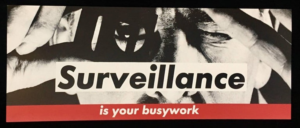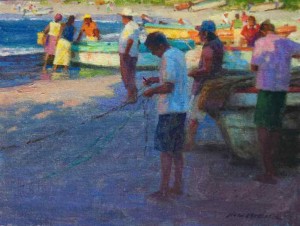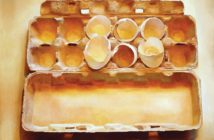Dear Artist,
Yesterday, my friend Chuck Putnins, whose other life is anesthesiology, wrote, “Next year I’ll be taking 6 months off work from May 1 to November 1. During that time I want to get better at painting and develop my own style. How do I best do this? I realize that the simple answer is ‘just paint Chuck,’ but I’m afraid of wasting a lot of time without some kind of structure. A plan is what is needed. Any ideas? I want to get the most out of my time off.”

Untitled (Your Body is a Battleground), 1989
Photographic silkscreen on vinyl
112 x 112 inches
by Barbara Kruger (b. 1945)
As well as being an accomplished visual artist, Kruger has had a distinguished career as Head Designer at Condé Nast, wrote columns for Artforum and taught at U.C. Berkeley.
I like this question. You know that I’ve got a system for anyone with a week, a month, or even for the big sabbatical at the end.
Think of putting a stew on a stove. You are going to live on this stew for the duration of your sabbatical. Every day you will take from it — and every day you will add to it. Sometimes your stew will be a “watched pot.” At other times it will be best left to bubble on its own. It will last from the minute of your beginning, to the minute of your finishing — always in a state of transformation and change.
You ought to structure your sabbatical by keeping notes of what’s going in and out of your pot. There will be surprises. Boiling over and boiling dry will be hazards. Sometimes you will have to refer to cookbooks. You’ll have to stack your cupboards. Clinging to the linear nature of your exercise, you’ll never loose sight of your cookery, and like a genie, your own true muse will arise from it. She will not bore you. The aroma of your concoction and the sense of discovery will have you up every morning, eager for the continued joy of the process, and it will keep you from the shallow temptations of the bars and dance halls.
Chuck, this is between you and me: There are those who will think I’m beginning to lose it. Pay no attention to them. I know you, and I know you can do it. You have imagination and ready ideas. Those that can’t stand the heat have to get out of the kitchen. Not you. You are going to love every minute. Also, for you it will be a nice change from needling people.
Best regards,
Robert

Untitled (How come only the unborn have the right to life?), 1982
Mixed media photograph and type on paper
8.75 x 5.88 inches
by Barbara Kruger
PS: “Paintings come out of themselves.” (Lawren Harris) “Every artist who evolves a style does so from illusive elements that inhabit his or her visual storehouse.” (Mary Carroll Nelson)
Esoterica: Commitment to projects can be reinforced by keeping a journal. “Weblogs,” or “Blogs” are online journals that proclaim a commitment to everyone out there. The intimate minutiae of progress can make surprisingly good reading, as well as satisfying narcissistic and exhibitionistic tendencies. “Blogging” is also used for building support groups, both spiritual and green.
This letter was originally published as “Sabbatical” on August 15, 2003.
“Although my art work was heavily informed by my design work on a formal and visual level, as regards meaning and content the two practices parted ways.” (Barbara Kruger)
Featured Workshop
Featured Artist
I was trained to become an Illustrator and did Illustration work for over 25 years. That experience gave me the discipline and skills to do a wide variety of subjects and in different mediums. Because of that I have been honored to be a “Designated Master” with both the American impressionist Society and the Oil Painters of America. I consider myself a “Traditional/Impressionist” and have worked hard to strive to keep my standards up and make a good work of art. As I tell my students..”an accomplished painting has an interesting and beautiful arrangement of shapes and colors”. That is what I strive to do, regardless of subject matter; to make a decent “work of Art”. I also have always loved to travel and am fascinated by different peoples and their cultures along with all of the beautiful and interesting landscapes that are part of this wonderful world that we live in. I feel very fortunate that I get to do what I really love to do.







154 Comments
I love this “stew on the stove” analogy for getting the most out of a painting or artistic practice to developing one’s work. I put my painting stew pot on the back of the stove for good in 2010. Before that, it was a scattering of one pot wonders that were tasty but didn’t have that long, satisfying , nourishment which comes with the consistency of regularly tending to a stew over many months or years. If it begins to feel repetitive, add some new spice or herb or seasonal garden vegetable that you hadn’t thought of trying. Even throw in some fruit maybe. Invite other stew lovers over and receive fresh appreciation for your culinary practices. But whatever you do, I am absolutely certain your artistic drive will not go hungry. Happy stew tending!
I once had the opportunity to spend a period of time focusing only on painting. I made sure all my tools stayed out. I didn’t want to waste time taking out and putting away. It is too easy to clean house or do the laundry or gardening and say “I’ll get to it this afternoon.”
The first, and most important thing, is to to turn off your phone. Let the answer machine or voicemail get it. you can check in when you have finished for the day. I put a note on my front door. “I am working, please come back after dinner.” Now I have removed all those things that would distract or interrupt.
If the canvas on the easel is pristine, scrub a few colors onto it. It doesn’t matter what. This is just to get you going. The greatest setbacks for artists are procrastination and the fear of failure. Even experience and discipline painters encounter this, especially if they have allowed a little or a lot of time to elapse between painting sessions. Scrubbing color on randomly gets you started. You will probably want to cover that up! Why not with a painting? Now with all distractions removed (no tv or radio except music) and paint on the canvas that may be incorporated into the work or obliterated, you are set to go.
The kind of work structure that a person who went to med school has is the same one as he will use in the studio. On vacation we wander with few plans, which is what many art dabblers do. But with 6 months, a working structure will help. Get up, drink coffee, check the stew pot, and go to your studio and play with your toys. Give yourself working hours.
The reason studios often look messy is because we leave our tools/toys out and they remind us where we are in our process. Just keep the brushes meticulously clean. One of my first painting teachers told us to “buy a quire of paper (25 sheets)” I did that, which was a wonderful lesson. Paper was always available. But the real lesson came when it was gone and I had to buy another. Paper is now sold in smaller packages, so buy a couple.
When the stew pot is empty, go find something tasty to add. New colors to test, doing your old color theory exercises, new papers, fresh canvas. Get stuff framed. Visit some galleries and museums, take a class or join a study group. All will feed the muse. Some of these won’t do the trick for you (too much garlic?) so leave them out.
Thanks Sara, for this wonderful blog.
I’m not a born artist but this is very inspiring!
Timely post. Thanks Sara,
I’ve just reconfigured my studio after a hiatus in anticipation a new body of work in a new direction.
So Terrific.
Also timely is Barb Kruger’s work (especially the third image) above, sadly still current forty years later.
I like the advice on telling artist’s to journal/blog. I’ve often wondered if it’s wrong to write about the personal side of making art, artists should only blog about accomplishments and ribbons and awards they walk across the stage to receive. I tend to lean towards personal perspectives. After reading Emily Carr’s published journals I was even more inspired to write about that instead of grand accomplishments and ribbons and awards. Then, thought, oh right, Emily Carr wrote in a diary and probably had no intention for it to be published in a book the public can buy. I am so happy I went full circle in my art life and came back here where I feel acceptance and inspiration. Social media is drenched with ego, sure done that myself, but this place is so much better. Yes, Robert, I’m constantly in a stew myself. Great letter!
Your style is your style. It comes naturally and evolves over time. You CANNOT develop a style in six months, at least not something you can easily repeat. It would be artificial. Friends have told ME “we note an evolution in your work”.
You’re right, Ben. I don’t understand the obsessing over style – as someone else has pointed out, it will develop. Everyone’s handwriting develops in a personal direction with time and practice – and so it is with style.
The great Impressionist painter Edgar Degas was visited by a friend one day. ‘Great news!’ he said. ‘Jacques (or whoever) is delighted that he’s finally discovered his style!’ Degas replied. ‘I hope I never discover my style – that would mean the end of everything.’
The irony is, of course, that Degas had a very recognisable style – but that was simply a by-product of his continuing work, not an end in itself.
The greatest setbacks for artists are procrastination and the fear of failure. Even experience and discipline painters encounter this, especially to http://www.drywallgreensboro.com if they have allowed a little or a lot of time to elapse between painting sessions.
A friend who does not paint but is curious asked me “how does one discover a style?” My first answer is “squeeze out and turn up the music.” Only half in jest. Look at it as a conversation between you and what’s out there/on paper/canvas. Step back, listen, be curious….and gracious. It’s a gift to be alive and giving your imagination free reign makes it juicier.
Simmering stews…great advice! I love that sometimes we just have to stew over things- May your style bubble up to delight not only your tastebuds but many others and have fun adding your personal touch.
Wow! This is so great. :)
Thanks
Thanks
I like the advice on telling artist’s to journal/blog. I’ve often wondered if it’s wrong to write about the personal side of making art, artists should only blog about accomplishments and ribbons and awards they walk across the stage to receive. I tend to lean towards personal perspectives.
Cooking stews at a low simmer… excellent tip! I like the fact that there are times when we just have to sit and mull things over; may your style eventually bubble up to pleasure not only your tastes but the tastebuds of many others, and may you have joy putting your own unique spin on things.
Thanks for this great info!
concrete contractor
This was very helpful
Actually, many decisions depend on us. This provides a better experience. The shares in the article really touch the readers. Each sentence has a connection and logic between viewpoints snake io
nsx8l9
9lrtuu
3kelr2
This is just to get you going. The greatest setbacks for artists in Marietta are procrastination and the fear of failure.
49em5o
kraaub
xyp2am
js81fn
c4v3wk
up8kbh
vaiqqg
Your point of view is as clear as a blind spot on an awning. It’s a lot to take in. I want to see what you write next fnaf
Thanks for the great content you shared here.
Your counsel and experience have been quite helpful, and I genuinely thank you. I want to offer my heartfelt gratitude for all of your assistance and expertise.
five nights at freddy’s
5x4na8
gt9hwy
04nzpe
86a130
7j0irn
Thank you for the great content you shared. excavation
Car racing games for mobile have gained massive popularity in recent years. Plenty of racing games are available in the market. Still, CarX Street has captured the hearts and thumbs of millions of racing game lovers around the globe with its high-quality graphics, realistic gameplay experience, wide range of cars, and exciting gameplay.
Amazing! I have some ideas in mind too. :)
Taking a sabbatical is an exhilarating adventure for Delaware Drywallers! It opens up a world of possibilities and new experiences.
It’s an informative article, thank you for taking the time to share it. fence installation
That’s great to hear. https://www.paramountsealcoating.com
By following these tips, you can make the most of your time off and achieve your artistic goals. Happy painting!
This is very informative, glad to check this site. retaining walls wellington
I enjoyed reading this. It was engaging and kept me interested throughout. demolition contractor
m02o92
Thank you for the great information you posted. Keep it up! concrete contractor
I like how the stew analogy makes the creative process feel natural and ever-changing, like you’re constantly adding new elements. The idea of keeping a journal or blog to track your progress is a solid way to stay motivated and focused. It’s a good reminder that art isn’t just about the finished product.
Also, if you’re curious, feel free to check out landscapingchilliwack.com
yva5yj
It’s truly very inspirational! The words resonate deeply, providing motivation for our Plaster repair and encouragement to pursue our dreams and overcome challenges.
dq0asu
gs34cr
kuetgg
Surprises are in store. According to colorado springs truck accident attorney, there will be risks of boiling over and boiling dry.
The stew idea is so clever and makes the whole process feel manageable and fun. Chuck’s approach shows how thoughtful he is about using his time well, and I think he’s on the right track with a plan like this. I can’t wait to hear how it all turns out for him. If you’re curious to learn more about our services, feel free to check us out at https://www.paintersgrandeprairie.com/interior-painting-grande-prairie
These details are good and asking the ideas from the audience brings the best new innovative ideas that we can work on to get amazing results. While getting the expert mobile mechanic in Spartanburg I saw how people are using these services to find the right solutions.
It could be a great option for us to see how it works. By using gutter repairs wa Perth I came to know about the service providers who are good at this.
You will probably want to cover that up for https://www.baltimoreconcreteservices. Why not with a painting?
yr67jc
x11vo9
This is awesome! Thanks for keeping us posted here.
jnvys7
I love the analogy of the stew – it really captures the essence of the creative process and the importance of structure while allowing for spontaneity. It’s great advice to keep track of what’s working and what isn’t, knowing that the journey will be full of surprises. Chuck’s plan sounds like it’s going to lead to a fulfilling and transformative experience.
Feel free to drop by http://www.interiordesigneredmonton.com if you’re interested, no pressure at all!
97f6w2
I’m so glad I found this blog. Your content is always so thoughtful and engaging!
aoc3xl
zbcmje
qxw1cg
3ozju4
I am not truly familiar with Sabbatical but thanks to our drywaller and thank to you, i was enlightened!
po2gok
That’s such a vivid and engaging response! The stew metaphor works beautifully as a way to describe the creative process—fluid, evolving, and requiring both structure and spontaneity. It acknowledges the need for discipline while embracing the surprises that come with artistic growth. The tone is both personal and encouraging, which makes it feel like a genuine letter rather than just advice. ppcpros.co/
g4u4lz
3obqrd
Great post! I’d love to see more informative posts here. https://gutterrepairauckland.co.nz/
I love the way this turns the learning process into something alive and evolving. The comparison to cooking makes it feel natural, like progress comes from steady effort and a bit of trust in the process. Chuck is in for something really special if he embraces it fully.
If you ever feel like exploring more, you are always welcome to visit Piano Movers Edmonton!
That’s such a rich and poetic way to think about a sabbatical—treating it like a slow-cooked stew, constantly evolving and deepening in flavor. Chuck’s concern is valid; it’s easy to let time slip away without structure, but your approach makes the process both structured and organic at the same time. blog
Sabbatical is the best detail for us, and we can see who the people are getting these updates here. While using the bird nesting prevention I saw how the people are getting these updates to find the right results.
h7bhim
It sounds like Chuck has a really exciting adventure ahead of him. I hope he has a fantastic and productive six months! Visit here
I love how you encourage a conversation with your readers. It makes your blog so interactive and enjoyable. Abbotsford Towing
Nice post! I’d love to see more informative articles on this site. screen company
zxq7d6
7kizv9
In Arab countries and Morocco, sports betting has become a popular pastime, and Linebet offers a wide range of sports to cater to diverse interests. From traditional sports like football to emerging options like esports, there’s something for everyone. Here are some of the best sports for betting on Linebet in these regions:
1. Football (Soccer) – Football is by far the most popular sport in both Arab countries and Morocco. With local leagues like the Moroccan Pro League (Botola Pro) and international competitions such as the English Premier League, La Liga, and the FIFA World Cup, football betting on Linebet offers numerous opportunities. The vast range of betting options, from match winner to specific events like total goals or first goal scorer, makes it an exciting choice for bettors.
2. Basketball – With basketball’s growing fan base in the Arab world, especially following the success of international leagues such as the NBA, basketball betting on Linebet is increasingly popular. Players can place bets on major tournaments like the NBA playoffs, EuroLeague, or local leagues. The ability to bet on game totals, player performances, and match outcomes adds extra layers of excitement.
3. Tennis – Tennis has a significant following in Arab countries, especially during major tournaments like Wimbledon, French Open, and Australian Open. Linebet offers a variety of betting options, including match winner, set betting, and even specific game results, which appeals to tennis fans in Morocco and across the region.
4. Volleyball – With the rise of regional volleyball leagues, Linebet offers betting markets for both men’s and women’s volleyball, including local competitions in Morocco and other Arab nations. International tournaments such as the FIVB World Cup and Olympic Games also attract a lot of interest for volleyball betting.
5. eSports – As competitive gaming continues to surge in popularity, esports betting on Linebet has become a strong contender. Popular games like CS:GO, Dota 2, and League of Legends offer diverse betting markets. Esports events are widely followed by young, tech-savvy bettors in the Arab world and Morocco, and Linebet offers exciting opportunities for those looking to bet on tournaments and individual matches.
6. Horse Racing – Although traditional, horse racing remains a popular betting choice in the Arab world. Major events like the Dubai World Cup attract significant attention, and Linebet offers various markets for horse racing enthusiasts.
7. Cricket – Cricket is growing in popularity in the Arab world, especially among communities from countries where cricket is a dominant sport, such as India and Pakistan. Linebet covers major tournaments like the ICC World Cup and IPL, providing bettors in Morocco and surrounding areas with ample opportunities.
8. MMA and Boxing – Combat sports like MMA and boxing continue to captivate sports fans across the Arab world. With popular events like the UFC and WBC boxing matches, https://linebets-arab.com/ma-fr offers exciting betting options on fight outcomes, round betting, and fighter performance.
In conclusion, Linebet offers a diverse range of sports betting options that cater to the interests of players in Arab countries and Morocco. Whether you’re into football, basketball, tennis, esports, or traditional sports like horse racing and boxing, Linebet has something to offer. With secure payment methods, local promotions, and a user-friendly interface, it’s an ideal platform for both novice and experienced bettors.
y0gtcf
Nice post! Thank you for sharing this great content. Tree Spraying
This is awesome! I’m glad to check this site. rotorua concrete
9ii7zh
2l75a6
omxe6n
The stew analogy Robert uses is such a creative way to frame Chuck’s sabbatical. It really emphasizes the idea that learning and growth are ongoing processes, constantly changing and evolving. It’s a great reminder that even during breaks, there’s always something new to discover. If you’re interested, feel free to visit my website at Landscaping Kamloops anytime!
x5q9r9
ba7osb
This is a beautiful metaphor for creative growth — turning a sabbatical into a simmering stew of daily practice, reflection, and curiosity. What stands out is the emphasis on process over perfection. Chuck’s instinct to seek structure is valid, but this post gently reminds us that structure doesn’t always mean rigidity — it can be as fluid and flavorful as a stew, evolving with each ingredient added. The key is to stay engaged, observant, and open to surprise. That’s not wasting time; that’s how an artist finds their flavor. This is similar to many concrete companies springfield il
ta3gwm
8eav51
6tdi77
5dbwho
tcns49
6j8jl8
8n4hkq
xhz34i
xuum3z
fd51vu
thk0w9
2ludzg
uo4afh
I really like how the stew metaphor makes the whole process of finding your style feel less stressful and more like an adventure. It’s true that having a plan helps, but leaving space for surprises is where the magic happens. I think Chuck is going to enjoy this journey a lot more than he expects.
If you’re curious or just feel like browsing, come check out my site at Electrician Kamloops – you’re always welcome.
kuvryz
Visit some galleries and museums, take a class, or join a study group.
Cheers,
finish basement
What a beautiful, encouraging letter — I love the stew metaphor for a creative process that simmers and deepens over time. Chuck’s in for something really special.
oaqste
lfsrcq
40x6hx
hnhhgg
2nkdnt
gbdzvj
Social media is drenched with ego, sure done that myself, but this place is so much better. Yes, Robert, I’m constantly looking for how much does concrete driveway cost
. Great letter!
r71xa8
guqyok
79yrzp
r6j1hz
gk0gy7
37rfpy
nuga72
il9mpl
tjwy3k
zi1gag
Some people might believe I’m starting to lose it. Ignore them. I know you’re capable of epoxy garage floor.
I like how Robert explained it with the stew example, it makes the whole process of creating art feel more natural and alive. Having structure without losing the joy of discovery sounds like the perfect balance for someone taking time off to focus on painting. It really shows that growth comes from patience and consistency.
bep5kb
n7c9nd
jnm6jb
xdpiiz
qb1bro
kv55nh
Enjoyed visiting your site—keep it up! Personal Trainer Sherwood Park
jfpdn5
s2ergl
14e63e
One thing I admire about the calculadora de finiquito is how user-friendly it is. You don’t need advanced knowledge to operate it. Just input the data, and it gives you clear results. It’s perfect for people who want accuracy without hiring an accountant or dealing with legal complexity.
zqlvmt
1f4tla
hlfh8f
5k47s2
It really doesn’t get better than this! https://www.wallremovalsperth.com.au
this sounds like a fantastic plan for Chuck! Taking 6 months off, specifically from May to November, is a really solid sabbatical idea. I’m especially curious to find out what he wants to ‘get bett…’ at during that time. Good for him for prioritizing that break!
jl4da0
I actually save this website, I love the free stuff provided here… Thanks a lot! Finishing Services
xkhyrr